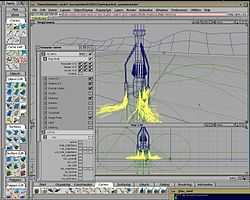PowerAnimator
| Developer(s) | Alias Systems Corporation |
|---|---|
| Stable release | 9.0.2 |
| Operating system | IRIX, AIX |
| Type | Computer graphics |
| License | Proprietary |
| Website | www.alias.com |
PowerAnimator and Animator, also referred to simply as "Alias", the precursor to what is now Maya and StudioTools, was a highly integrated industrial 3D modeling, animation, and visual effects suite. It has had a long track record, starting with Terminator 2: Judgment Day in 1991 and ending in Star Wars Episode I: The Phantom Menace in 1999. PowerAnimator ran natively on MIPS based SGI IRIX and IBM AIX systems up until the late 1990s when it was superseded by Maya.
The software
The software itself featured one of the most complex user interfaces ever created, which allowed for an incredible amount of control over scene parameters, but made many tasks, such as animation, cumbersome and non-intuitive. It was expensive as well, apart from the enormous cost of SGI systems at the time. The standalone software retailed for $7,500, but was also sold with other modules, and a PowerPack containing all modules that retailed for US$30,000.
Alias PowerAnimator 9.0 documentation
- Animating in Alias 9.0 (436 pages) - Provides information to help you create basic animations, build skeletons, bring creatures to life using Inverse Kinematics, produce particles and special effects, and deform time using time warps.
- Basic Tools in Alias 9.0 (610 pages) - General tools that you'll use throughout modeling, animating, or rendering workflows.
- Data Transfer for CAD and Solid imaging in Alias 9.0 (212 pages) - Explains how to exchange 3D model data between Alias 9.0 and CAD packages.
- Games Data transfer in Alias 9.0 (130 pages) - Explains how to translate Alias files to games platforms such as Nintendo 64, Sony PlayStation, and Sega Saturn.
- Learning Alias 9.0 (674 pages) - A thorough course in learning how to use the Alias design and animation software.
- NURBS Modeling in Alias 9.0 (554 pages) - Tools to create and modify NURBS curves and surfaces, as well as construction and evaluation tools.
- Polygonal Modeling in Alias 9.0 (120 pages) - Tools to create and modify polygons and polysets.
- Rendering in Alias 9.0 (562 pages) - Tools to define the look of your scene, create special effects, define how the scene will render, and create final rendered images and animations.
- Global Index for Alias 9.0
History
PowerAnimator was launched in 1990.[1]
In 1997, John Gibson, Rob Krieger, Milan Novacek, Glen Ozymok, and Dave Springer were presented with the Scientific and Engineering Award for their contributions to the geometric modeling component of the PowerAnimator system. The citation was:
"The Alias PowerAnimator system is widely regarded in the computer animation field as one of the best commercially available software packages for digital geometric modeling. Used by many motion picture visual effects houses, it has been a benchmark for comparison of modeling tools and has had a major influence on visual effects and animation." [2]
PowerAnimator was previously used in the creation of animation for the TV series South Park.
Television and film

The software's more notable contributions to the entertainment industry can be found in films like The Abyss, Jurassic Park and Terminator 2: Judgement Day.
PowerAnimator was used to create the water creature in the 1989 film The Abyss, as well as the T-1000 character in Terminator 2: Judgment Day, at a cost of $460,000 per minute. It was also used heavily for the many visual effects of the 1996 film Independence Day. PowerAnimator also served as the solution used to produce South Park episodes digitally before production was moved to Maya. The title sequence of Disney's One Saturday Morning was created using Alias Wavefront Power Animator.
- Disney's One Saturday Morning
- The Abyss
- Terminator 2: Judgment Day
- Jurassic Park
- Independence Day
- South Park
- Batman Returns
- James and the Giant Peach
- Forrest Gump
- The Mask
- Speed
- Dragonheart
- The Flintstones
- True Lies
- Futurama
Game development
PowerAnimator was also used in game development, in particular as a part of Nintendo 64's SGI-based developers kit. It saw some use for modeling, texturing, animation and realtime effects for other titles and platforms as well.
Notable titles:
- Crash Bandicoot[3]
- Super Mario 64
- Mario Kart 64
- Donkey Kong Country
- GoldenEye 007
- Turok: Dinosaur Hunter
- Turok 2: Seeds of Evil
- The Legend of Zelda: Ocarina of Time
- Final Fantasy VII
- Oddworld: Abe's Oddysee
- Oddworld: Abe's Exoddus
Other titles include:
- Star Wars Arcade (1993)
- Star Trek: The Next Generation - A Final Unity
- Super Turrican 2
- Quake
- Fallout 2